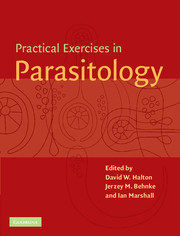Book contents
- Frontmatter
- Contents
- List of contributors
- Preface
- General advice
- 1 Observational Exercises on Parasites
- A Local wild and domestic hosts as sources of parasites
- B Laboratory maintained species
- 1.8 Protozoan parasites of the intestinal tract of the cockroach, Periplaneta americana
- 1.9 Protozoan parasites of the mouse intestinal tract
- 1.10 Rodent malaria
- 1.11 Malaria: an example of a vector transmitted parasite
- 1.12 Larval and adult Echinostoma spp. (Trematoda)
- 1.13 Schistosoma mansoni (Trematoda)
- 1.14 Hymenolepis diminuta (Cestoda)
- 1.15 Heligmosomoides polygyrus (Nematoda)
- 2 Ecology
- 3 Physiology and Biochemistry
- 4 Pathology and Immunology
- 5 Chemotherapy
- 6 Molecular Parasitology
- 7 Behaviour
- Appendix 1 Reagent index
- Appendix 2 UK suppliers
- Appendix 3 US suppliers
- Index
1.15 - Heligmosomoides polygyrus (Nematoda)
Published online by Cambridge University Press: 05 June 2012
- Frontmatter
- Contents
- List of contributors
- Preface
- General advice
- 1 Observational Exercises on Parasites
- A Local wild and domestic hosts as sources of parasites
- B Laboratory maintained species
- 1.8 Protozoan parasites of the intestinal tract of the cockroach, Periplaneta americana
- 1.9 Protozoan parasites of the mouse intestinal tract
- 1.10 Rodent malaria
- 1.11 Malaria: an example of a vector transmitted parasite
- 1.12 Larval and adult Echinostoma spp. (Trematoda)
- 1.13 Schistosoma mansoni (Trematoda)
- 1.14 Hymenolepis diminuta (Cestoda)
- 1.15 Heligmosomoides polygyrus (Nematoda)
- 2 Ecology
- 3 Physiology and Biochemistry
- 4 Pathology and Immunology
- 5 Chemotherapy
- 6 Molecular Parasitology
- 7 Behaviour
- Appendix 1 Reagent index
- Appendix 2 UK suppliers
- Appendix 3 US suppliers
- Index
Summary
Aims and objectives
This exercise is designed to demonstrate:
The external and internal morphology of the adult stage of the nematode parasite Heligmosomoides polygyrus.
The mating behaviour of the adult worms.
The distribution of worms in the small intestine and the selection of a preferred site.
Introduction
Intestinal nematode parasites are very common in mammalian hosts and are responsible for human disease as well as for losses to the agricultural industries through their effects on domestic animals. H. polygyrus (Fig. 1.15.1) is an intestinal nematode parasite of mice that is very easy to maintain in the laboratory and provides convenient material to demonstrate some of the adaptations that have evolved in nematodes for survival in their hosts.
Unfortunately, this parasite has been the subject of a longstanding taxonomic debate as to the most appropriate name for the species. These problems are discussed by Behnke et al. (1991) and the reader is referred to this publication for further details. The approach used here is that the alternative name for the species, Nematospiroides dubius, is no longer used. H. polygyrus bakeri is the strain maintained in domestic/laboratory mice, Mus musculus. In Europe, however, wild field or wood mice, Apodemus sylvaticus, carry the subspecies called H.p. polygyrus and voles, Clethrionomys glareolus, H. glareoli. All of these, if available, can provide useful teaching material. This protocol is based on the laboratory passaged subspecies H. polygyrus bakeri.
- Type
- Chapter
- Information
- Practical Exercises in Parasitology , pp. 123 - 130Publisher: Cambridge University PressPrint publication year: 2001

